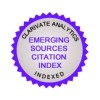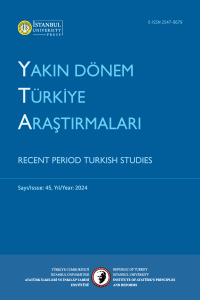Research Article
Aim & Scope
Recent Period Turkish Studies – Yakın Dönem Türkiye Araştırmaları is a scientific, open-access and peer-reviewed journal published biannually (June & December). The journal publishes original articles and studies from the disciplines of history, History of the Republic of Turkey, Atatürk’s Principles and History of Turkish Reforms, Ottoman History, sociology, literature, art history, law, political science and economics within the framework of Modern Turkish and World History. Thus it serves as a bridge between the world of science and academicians at the national and international levels.
The objective of the journal is to contribute to science by publishing research articles and reviews in Turkish and English.
Recent Period Turkish Studies – Yakın Dönem Türkiye Araştırmaları has a scope that covers the disciplines of history, History of the Republic of Turkey, Atatürk’s Principles and History of Turkish Reforms, Ottoman History, sociology, literature, art history, law, political science and economics within the framework of Modern Turkish and World History.
The journal publishes, research articles and reviews evaluating and criticizing the studied subjects and presenting new and remarkable opinions on the basis of a rich bibliography. Translations related to the field and texts of unpublished papers that were previously presented at a scientific congress; introductory letters about treatises, personalities and scientific activities about the Turkish National Campaign and Republic of Turkey are included in the journal as well.
Author Guidelines
MANUSCRIPT ORGANIZATION AND FORMAT
All correspondence will be sent to the first-named author unless otherwise specified. Article is to be submitted online via https://dergipark.org.tr/login that can be accessed at http://rpts.istanbul.edu.tr. It must be accompanied by a title page specifying the article category (i.e. research article, review etc.) and including information about the essay (see the Submission Checklist), and a cover letter. Articles should be prepared in Microsoft Word 2003 and upper versions. In addition, Copyright Agreement Form that has to be signed by all authors must be submitted. The Cover Page and Copyright Form must be completed in full.
1. Studies should be in A4 paper standards: having 4 cm margin from left and 2.5 cm margins from right, bottom and top, Times New Roman font style in 12 font size, line spacing of 1.5 and “justify align” format. If there are footnotes, they must remain within these limits and be written in 10 font size. Before and after paragraphs, 6 point space should be left.
2. The headings of sections and subsections of the article should be in 14 font size. Before and after headings, 6 point space should be left.
3. Headings and subheadings should not be in the last line of a page; in such a case they should be on the next page. The first line of a paragraph should not be the last line of a page and the last line of a paragraph should not be the first line of page.
4. Abbreviations, table, figure and symbol list, preface, abstract, references list, appendix and explanations of tables and captions of figures should be written in 1 line spacing.
5. The author/authors’ names and information should not be included in the text of the article, and all information about the author/authors should be indicated on the Cover Page that will be uploaded to the system along with the Full Text and Copyright Form. The Cover Page should include the title of the article, the author or authors’ affiliations and titles, the addresses where they can be reached, mobile, business and fax numbers, ORCID and e-mail addresses.
6. Before the introduction part, there should be an abstract of 100-200 words both in Turkish and in English. An extended abstract in English between 600-800 words, summarizing the scope, the purpose, the results of the study and the methodology used is to be included following the abstracts. Underneath the abstracts, 5 keywords that inform the reader about the content of the study should be specified in Turkish and in English.
7. The article should contain mainly these components: Title, abstract and keywords in the language of the article; English title, abstract and keywords; extended abstract in English, main sections of article, references and tables and figures.
8. Tables, graphs and figures can be given with a number and a defining title if and only if it is necessary to follow the idea of the article. Otherwise, data that can be given in the text, such as demographic characteristics, should not be expressed in separate tables.
9. All responsibility for the articles/writings published in the journal and the opinions expressed belong to the authors; Istanbul University Institute of Ataturk’s Principles and Revolution History does not assume any responsibility.
10. In line with the editorial board and referee reports, authors may be asked to make some corrections on the text.
Citations (Reference, Cross Reference)
In the article, quotations from other sources are either quoted exactly or summarized or interpreted by the author’s own words, provided that the essence is not changed. In both cases, the cited source (including text, table, figure etc.) must be referenced. The following principles are applied in this regard:
a. Information taken exactly from the source (quotation) is shown in double quotes (“.....”). Quotations made by the author by changing the format, not the essence of the information in the source, are shown without double quotes. In both types of citations, reference is made to the relevant source and each citation is given a consecutive number in the form of footnotes on the bottom of the page.
b. In the article, the whole of the information quoted from the source can be given, but for example, only certain parts of the information in the form of sentences, paragraphs or pages can also be given. In this case, the omitted places are indicated with three dots (…) to show that certain words, various sentences, paragraphs and pages are omitted in the sentences.
c. If the information in other sources is quoted verbatim, inaccuracies such as letters, sentences, dates, places, etc. in the sources are also repeated, including punctuation marks and translation errors. If the author of the article wants to give correction of inaccuracies in the source text, then the correct information is indicated in a parenthesis immediately after the incorrect information.
d. Exact quotations from the sources are given within the text of the article, if they are not longer than one sentence. In longer quotations, at least double-spaced space is left between the first and last lines of the quotation and the text of the article, so that the quotation and the text are distinguished. For such citations, a smaller font size than the font used in the article text is used.
Rules about Reference Footnotes
In the reference footnotes, if a reference is made to the relevant source for the first time, the full bibliography of the work (author’s name, surname, name of the work, translator/editor/compiler information, if any, place of publication, publisher and date) should be given. Namely:
Salahi Ramazan Sonyel, Türk Kurtuluş Savaşı ve Dış Politika I, Türk Tarih Kurumu Yayınları, Ankara, 1973, s. 10.
Erol Güngör, Kültür Değişmesi ve Milliyetçilik, 2. Baskı, Ötüken Yayınları, İstanbul, 1984, s. 24.
If a second or more reference is made to the same source in reference footnotes, the above information is abbreviated accordingly:
Erol Güngör, Kültür Değişmesi …, s. 35.
Reference to the author’s article/book chapter in the edited book:
First reference:
Hüseyin Bağcı, “Demokrat Parti’nin Ortadoğu Politikası”, Türk Dış Politikasının Analizi, der. Faruk Söylemezoğlu, Der Yayınları, İstanbul, 1994, s. 93-94.
Next references:
Hüseyin Bağcı, “Demokrat Parti’nin Ortadoğu Politikası”, s. 98.
Reference to the article in the periodical:
First reference:
Fahrettin Kırzıoğlu, “Mustafa Kemal Paşa-Erzurum İlişkileri (1919-1920)”, Atatürk Araştırma Merkezi Dergisi, VII/20, 1991, s. 223-266.
Mustafa Budak, “Ermeni Meselesi Açısından Başbakanlık Osmanlı Arşivi’nin Önemi”, Yakın Dönem Türkiye Araştırmaları Dergisi, C. 17, S. 34, 2018, s. 209.
Next references:
Fahrettin Kırzıoğlu, “Mustafa Kemal Paşa-Erzurum İlişkileri (1919-1920)”, s. 225.
Articles and news in newspapers should be displayed as follows:
“Hükümet-i Osmaniyye’nin Sulh Konferansına Teklifâtını Hâvi Muhtıra”, İkdam, 3 Mart 1335 (1919), s. 1.
“DP Kongresi Saat 10’da Açıldı”, Vakit, 15 Ekim 1955, s. 1-2.
“İnönü ve Gülek’in Menderes’e Geçmiş Olsun Telgrafları”, Ulus, 19 Şubat 1959, s. 1-2.
Reference to archival documents:
Türkiye Cumhuriyeti Cumhurbaşkanlığı Devlet Arşivleri Başkanlığı Osmanlı Arşivi (BOA), Bab-ı Âlî Evrak Odası (BEO), 3733/236781 (Sadaret’ten Harbiye Nezareti’ne gönderilen 1 Teşrîn-i Sânî 1326 [14 Kasım 1910] tarihli tezkire).
Türkiye Cumhuriyeti Cumhurbaşkanlığı Devlet Arşivleri Başkanlığı Cumhuriyet Arşivi (BCA), 030-01-37/222-1 (6-7 Eylül olaylarında zarar görenlere maddi destekler hakkında).
The names of the same archives and fonds should be written with their codes in the second and subsequent citations:
BOA, BEO, 3733/236781.
Reference to the electronic/internet source:
TBMM, Süreli Yayınlar, III. Menderes Hükümeti, (Çevrimiçi), www.tbmm.gov.tr, 8 Aralık 2013.
Ayhan Kamel, “İkinci Dünya Savaşı’nın Bitiminden Günümüze Kadar Türk-Rus İlişkileri”, (Çevrimiçi), www.dispolitika.org.tr, 7 Aralık 2013.
John N. Berry, “Educate Library Leaders”, Library Journal, February 15, 1998 (Çevrimiçi), http//www.epnet.com/ehost, 3 Nisan 2019.
Bibliography
In the bibliography, books and articles should be shown as follows:
Satan, Ali: Türk ve İngiliz Belgelerinde Halifeliğin Kaldırılması, Yazıgen Yayıncılık, İstanbul, 2017.
Türkmen, Zekeriya: “Mustafa Kemal Paşa ve Yıldırım Orduları Grup Komutanlığı”, Atatürk Araştırma Merkezi Dergisi, C. XVI, S. 47, Temmuz 2000, s. 395-419.
Appendix/Appendices
The appendix section of the article contains text-related pictures, tables, forms, lists of survey questions, copies of important documents, photographs, maps, etc. For such a single material, only one annex is included, and for more than one material, if deemed necessary, multiple annexes are included. If the appendices are to be distinguished from each other, they shall be numbered consecutively as “Appendix-1”, “Appendix-2”, and so on. It is recommended that each number be followed by a title indicating the content of the each appendix. A title describing the contents of the appendix is recommended to be put next to each number.
If the information in the appendix is conveyed from other sources, references to these sources must be indicated in the footnote.
Numbering titles:
The following illustration shows the title numbering template to be used in the article:
1. XXXXXX.................................................................................................…..
1.1. Xxxx Xxxx......................................................................................
1.1.1. Xxxx Xxxx...................................................................…
1.1.2. Xxxx Xxxx.......................................................................
2. Xxxx Xxxx...............................................................................................…..
2.1. Xxxx Xxxx......................................................................................
2.1.1. Xxxx Xxxx.................................................................…..
2.1.2. Xxxx Xxxx..................................................................….
2.2 Xxxx Xxxx.......................................................................................
Ethical Principles and Publication Policy
Publication Ethics and Malpractice Statement
Recent Period Turkish Studies- Yakın Dönem Türkiye Araştırmaları is committed to upholding the highest standards of publication ethics and pays regard to Principles of Transparency and Best Practice in Scholarly Publishing published by the Committee on Publication Ethics (COPE), the Directory of Open Access Journals (DOAJ), the Open Access Scholarly Publishers Association (OASPA), and the World Association of Medical Editors (WAME) on https://publicationethics.org/resources/guidelines-new/principles-transparency-and-best-practice-scholarly-publishing
All submissions must be original, unpublished (including as full text in conference proceedings), and not under the review of any other publication synchronously. Authors must ensure that submitted work is original. They must certify that the manuscript has not previously been published elsewhere or is not currently being considered for publication elsewhere, in any language. Applicable copyright laws and conventions must be followed. Copyright material (e.g. tables, figures or extensive quotations) must be reproduced only with appropriate permission and acknowledgement. Any work or words of other authors, contributors, or sources must be appropriately credited and referenced.
Each manuscript is reviewed by one of the editors and at least two referees under double-blind peer review process. Plagiarism, duplication, fraud authorship/denied authorship, research/data fabrication, salami slicing/salami publication, breaching of copyrights, prevailing conflict of interest are unnethical behaviors.
All manuscripts not in accordance with the accepted ethical standards will be removed from the publication. This also contains any possible malpractice discovered after the publication. In accordance with the code of conduct we will report any cases of suspected plagiarism or duplicate publishing.
Research Ethics
Recent Period Turkish Studies- Yakın Dönem Türkiye Araştırmaları adheres to the highest standards in research ethics and follows the principles of international research ethics as defined below. The authors are responsible for the compliance of the manuscripts with the ethical rules.
- Principles of integrity, quality and transparency should be sustained in designing the research, reviewing the design and conducting the research.
- The research team and participants should be fully informed about the aim, methods, possible uses and requirements of the research and risks of participation in research.
- The confidentiality of the information provided by the research participants and the confidentiality of the respondents should be ensured. The research should be designed to protect the autonomy and dignity of the participants.
- Research participants should participate in the research voluntarily, not under any coercion.
- Any possible harm to participants must be avoided. The research should be planned in such a way that the participants are not at risk.
- The independence of research must be clear; and any conflict of interest or must be disclosed.
- In experimental studies with human subjects, written informed consent of the participants who decide to participate in the research must be obtained. In the case of children and those under wardship or with confirmed insanity, legal custodian’s assent must be obtained.
- If the study is to be carried out in any institution or organization, approval must be obtained from this institution or organization.
- In studies with human subject, it must be noted in the method’s section of the manuscript that the informed consent of the participants and ethics committee approval from the institution where the study has been conducted have been obtained.
Author's Responsibilities
It is authors’ responsibility to ensure that the article is in accordance with scientific and ethical standards and rules. And authors must ensure that submitted work is original. They must certify that the manuscript has not previously been published elsewhere or is not currently being considered for publication elsewhere, in any language. Applicable copyright laws and conventions must be followed. Copyright material (e.g. tables, figures or extensive quotations) must be reproduced only with appropriate permission and acknowledgement. Any work or words of other authors, contributors, or sources must be appropriately credited and referenced.
All the authors of a submitted manuscript must have direct scientific and academic contribution to the manuscript. The author(s) of the original research articles is defined as a person who is significantly involved in “conceptualization and design of the study”, “collecting the data”, “analyzing the data”, “writing the manuscript”, “reviewing the manuscript with a critical perspective” and “planning/conducting the study of the manuscript and/or revising it”. Fund raising, data collection or supervision of the research group are not sufficient roles to be accepted as an author. The author(s) must meet all these criteria described above. The order of names in the author list of an article must be a co-decision and it must be indicated in the Copyright Transfer Form. The individuals who do not meet the authorship criteria but contributed to the study must take place in the acknowledgement section. Individuals providing technical support, assisting writing, providing a general support, providing material or financial support are examples to be indicated in acknowledgement section.
All authors must disclose all issues concerning financial relationship, conflict of interest, and competing interest that may potentially influence the results of the research or scientific judgment.
When an author discovers a significant error or inaccuracy in his/her own published paper, it is the author’s obligation to promptly cooperate with the Editor-in-Chief to provide retractions or corrections of mistakes.
Responsibility for the Editor and Reviewers
Editor evaluates manuscripts for their scientific content without regard to ethnic origin, gender, sexual orientation, citizenship, religious belief or political philosophy of the authors. Editor provides a fair double-blind peer review of the submitted articles for publication and ensures that all the information related to submitted manuscripts is kept as confidential before publishing.
Editor is responsible for the content and overall quality of the publication and must publish errata pages or make corrections when needed.
Editor does not allow any conflicts of interest between the authors, editors and reviewers. Only editor has the full authority to assign a reviewer and is responsible for final decision for publication of the manuscripts in the Journal.
Reviewers’ judgments must be objective. Reviewers must ensure that all the information related to submitted manuscripts is kept as confidential and must report to the Editor if they are aware of copyright infringement and plagiarism on the author’s side.
A reviewer who feels unqualified to review the topic of a manuscript or knows that its prompt review will be impossible should notify the Editor and excuse himself from the review process.
Price Policy
All expenses of the journal are covered by the Istanbul University. Processing and publication are free of charge with the journal. There is no article processing charges or submission fees for any submitted or accepted articles.
Indexes
Journal Boards
Owner
Danışma Kurulu



Sekreterya










